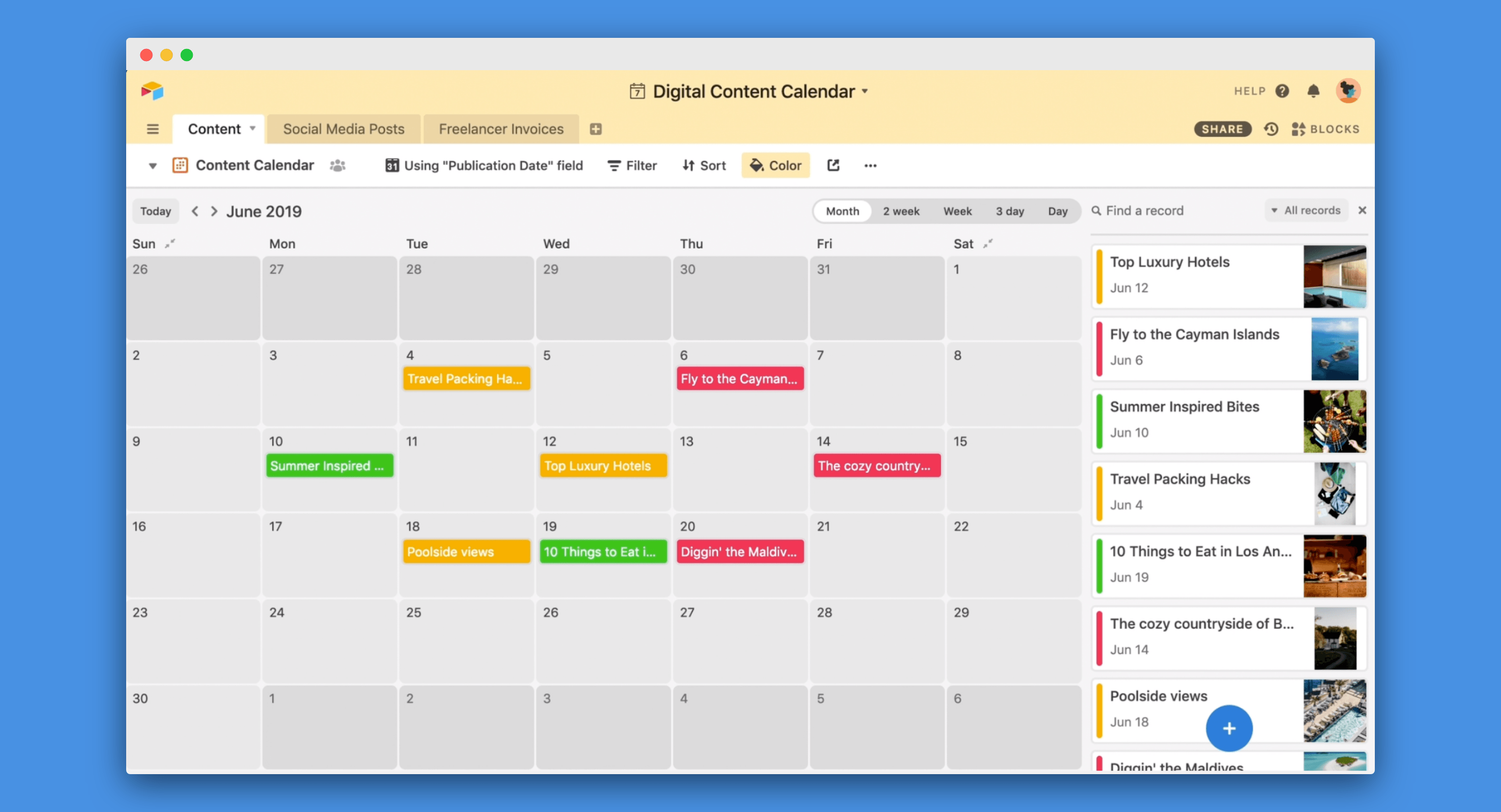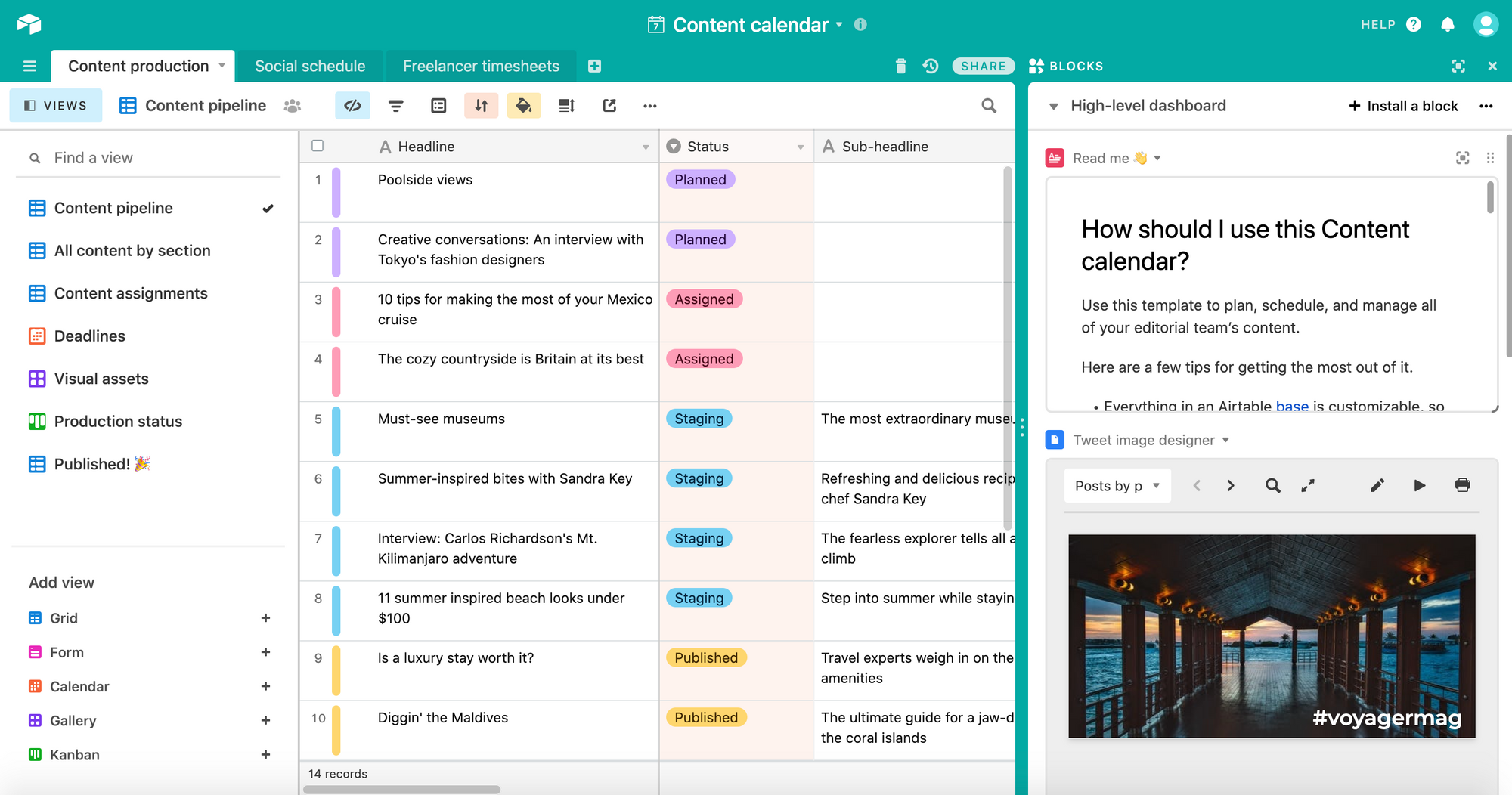

A single database stores all the information of a particular project. There are 6 basic components of an Airtable Database:ĭatabases in Airtable are known as Bases. Understanding the 6 Basic Components of Airtable Basic Knowledge of Relational Databases.They cover a wide range of basic use cases and are ideal starting points for creating your own custom Bases. Templates: For the template gallery, Airtable has assembled a variety of pre-made Template Bases.Notifications are presently triggered when someone shares a base with you, adds you to a workspace, you in a record, or assigns you to a record using a collaborator field. Automatic Notifications: When anything significant occurs in Airtable, you will be informed via notifications.
 Collaborative Workspace: The collaboration capabilities enable different divisions to effortlessly collaborate and manage teamwork. You can even move your events from your Calendar into Airtable. If you use Airtable to plan and schedule, you can import information from Airtable to an external Calendar app that you’d like to keep in sync. Calendar Management: You can integrate your Calendar app with Airtable. Restoring a base from a snapshot will produce a new base that will not interfere with your existing base. Snapshots: Airtable automatically takes snapshots of your Bases regularly, and you may also manually take a snapshot. Some of the Application Integrations offered by the vendor are Dropbox, LinkedIn, WordPress, Slack, Gmail, GitHub, Twitter, etc. Airtable has built-in support for many popular Applications and a Robust API. Application integration: Integrations help you automatically move information back and forth between Airtable and other apps. And the Tables are related through Linked Airtable Records. Data is stored in the form of Records (rows) and Fields (columns) in a Table. Relational Database Functionality: The Bases in Airtable follow the functionality of the Relational Database. Some examples of views are the Grid view, Calendar view, Gantt view, etc. You can use them according to the way you want to view the data. Customized Views: Airtable provides Customized views. You don’t even need to know SQL, in fact not any kind of scripting. Few common use cases for Airtable are Content Calendar, Project Management, Event Planning, Product Catalog, Job Hunting, etc.įor further information about the services and usage of Airtable, please follow the Official Documentation. You may use it to save, organize, and collaborate on information about anything, including employee directories, product inventory, and even student records. It allows anyone to create a database in minutes. The User Interface of Airtable is Straightforward, Colorful, and User-friendly. Airtable makes it easy to interact with your data while also enabling Programmatic Data Management. It is one of the numerous no-code tools that are gaining popularity. It is easy to use and allows anybody to rapidly construct a database. Airtable Linked Records: Linking Two Existing TablesĪirtable is a progressive Spreadsheet Application with Database Capabilities. Airtable Linked Records: Converting an Existing Field into a New Linked Table. Understanding the 6 Basic Components of Airtable. Read along to find out how you can Link Records in Airtable seamlessly. You will also gain a holistic understanding of Airtable Linked Records. In this article, you will have an understanding of the process of setting up Airtable Linked Records.
Collaborative Workspace: The collaboration capabilities enable different divisions to effortlessly collaborate and manage teamwork. You can even move your events from your Calendar into Airtable. If you use Airtable to plan and schedule, you can import information from Airtable to an external Calendar app that you’d like to keep in sync. Calendar Management: You can integrate your Calendar app with Airtable. Restoring a base from a snapshot will produce a new base that will not interfere with your existing base. Snapshots: Airtable automatically takes snapshots of your Bases regularly, and you may also manually take a snapshot. Some of the Application Integrations offered by the vendor are Dropbox, LinkedIn, WordPress, Slack, Gmail, GitHub, Twitter, etc. Airtable has built-in support for many popular Applications and a Robust API. Application integration: Integrations help you automatically move information back and forth between Airtable and other apps. And the Tables are related through Linked Airtable Records. Data is stored in the form of Records (rows) and Fields (columns) in a Table. Relational Database Functionality: The Bases in Airtable follow the functionality of the Relational Database. Some examples of views are the Grid view, Calendar view, Gantt view, etc. You can use them according to the way you want to view the data. Customized Views: Airtable provides Customized views. You don’t even need to know SQL, in fact not any kind of scripting. Few common use cases for Airtable are Content Calendar, Project Management, Event Planning, Product Catalog, Job Hunting, etc.įor further information about the services and usage of Airtable, please follow the Official Documentation. You may use it to save, organize, and collaborate on information about anything, including employee directories, product inventory, and even student records. It allows anyone to create a database in minutes. The User Interface of Airtable is Straightforward, Colorful, and User-friendly. Airtable makes it easy to interact with your data while also enabling Programmatic Data Management. It is one of the numerous no-code tools that are gaining popularity. It is easy to use and allows anybody to rapidly construct a database. Airtable Linked Records: Linking Two Existing TablesĪirtable is a progressive Spreadsheet Application with Database Capabilities. Airtable Linked Records: Converting an Existing Field into a New Linked Table. Understanding the 6 Basic Components of Airtable. Read along to find out how you can Link Records in Airtable seamlessly. You will also gain a holistic understanding of Airtable Linked Records. In this article, you will have an understanding of the process of setting up Airtable Linked Records. 
These tables related through Airtable Linked Records tend to have a “ Reciprocal Relationship” among them. Airtable Linked Records are the way of establishing relationships between tables. Moreover, Airtable uses features of Relational Databases. Airtable claims to be able to “ organize anything, with anybody, from anywhere.” Data that is related to one another can be linked together. This platform is primarily concerned with data organization and collaboration. And this is where Airtable comes into the picture! It combines the Functionality of a Database and the Style of a Spreadsheet in such a manner that users are constantly aware of what is going on.Īirtable is a Cloud-Based Project Management Tool targeting small and medium-sized enterprises, as well as departments inside bigger corporations. They don’t opt for using databases because these often require SQL scripting skills. Even after having the requirements to deal with huge chunks of data, organizations still use Spreadsheets for analysis, instead of Databases.







 0 kommentar(er)
0 kommentar(er)
